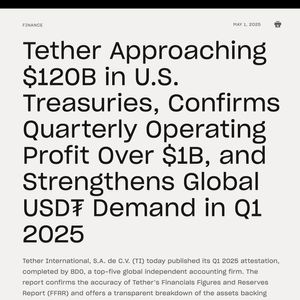Does the Bitcoin halving hit all miners equally? As power costs diverge globally, can high-cost countries stay in the game? And what happens if mining concentrates too far in too few hands? One coin, many realities A Bitcoin ( BTC ) is always worth the same on paper. Whether it is mined in Nigeria or Norway, it holds the same market value. But the cost, effort, and practicality of mining that coin vary dramatically depending on location. According to data compiled by NFT Evening, the cost to mine one Bitcoin now ranges from just above $8,000 in Ethiopia to more than $320,000 in Ireland — a nearly fortyfold difference. The code remains constant, but the realities of energy policy, currency stability, infrastructure, and local grids create sharp economic divergence. Russians can mine one Bitcoin for 39k and sell it for 95k. pic.twitter.com/PsuOJCHTmn — Duo Nine ⚡ YCC (@DU09BTC) April 30, 2025 Ethiopia stands out as the lowest-cost country in the dataset, with an average mining cost of around $8,200. There is little public narrative around mining from the region, yet its pricing makes it one of the most viable locations globally. Ireland represents the opposite end. At over $321,000 per Bitcoin, the cost makes mining economically unfeasible unless supported by external subsidies or repurposed for energy experimentation. Other European nations, including Italy, Germany , and the Netherlands, fall into the same high-cost category, shaped by expensive power rates and dense regulatory environments. Even countries that actively promote Bitcoin are not exempt from these pressures. El Salvador, despite its national-level support and adoption efforts, has an average mining cost above $150,000. Its position sits closer to high-cost jurisdictions than to resource-advantaged nations. What emerges is a new kind of digital inequality. It does not stem from the protocol itself. It comes from everything that surrounds it — the energy markets, the politics, and the cost of access. Let’s explore this further. The halving did not hurt everyone the same Bitcoin’s halving is mechanical. Every 210,000 blocks, the reward for mining is cut in half. It happens roughly once every four years and requires no discussion, vote, or approval. In April 2024, the latest halving reduced the block reward from 6.25 to 3.125 BTC. While this change was expected, its effects were not felt equally. Depending on the country, the shift either reinforced mining strength or forced operations into retreat. At the lower end of the cost spectrum, Ethiopia stood firm. With an average mining cost of $8,200 per BTC, the halving did not pose an existential threat. As long as electricity and hardware access remain steady, miners there can continue with relatively low risk. Middle-tier countries like Kazakhstan and Uzbekistan experienced mixed outcomes. Kazakhstan’s average cost of $33,400 left room for profit, especially with efficient ASICs. But increasing policy restrictions and tightening regulations are starting to reduce its attractiveness as a mining hub. High-cost nations faced the sharpest impact. In countries like Brazil and Turkey, which were already at the edge of profitability, with mining costs of $141,000 and $117,000 respectively, the halving pushed operations into unviability. Without access to heavily discounted or off-grid energy, most miners in these regions are now operating at a loss. In the United Kingdom and South Korea, the situation is even more extreme. With average mining costs above $200,000 per BTC, the halving effectively removed these countries from the global mining equation. In South Korea specifically, over $260,000 in electricity expenditure is now required to produce one coin. In Japan, the cost surpasses $140,000. Mining in these regions is only possible if Bitcoin’s price surges well beyond current levels. Some miners have responded by adopting new strategies. In the U.S., several have secured long-term power purchase agreements to stabilize energy costs. Others have moved operations to countries like Paraguay and Oman, where hydropower and government incentives offer continued viability. A few have downsized or diversified into other sectors such as AI compute or general data infrastructure to remain profitable. Even countries with pro-Bitcoin policies are not exempt from this reshuffling. El Salvador, despite its national-level push for adoption, faces an average mining cost of over $150,000, placing it closer to Germany than to low-cost countries. The design assumptions vs. today’s mining economics Bitcoin was built with clarity in mind. Its software defined every rule — how new coins are created, how blocks are added, how rewards are halved, and how difficulty adjusts with activity. The protocol left no room for improvisation. It was rigid by design. But the world it entered was anything but stable. The gap between how Bitcoin was written and how it now operates has grown with every passing year. In 2008, before Bitcoin’s public release, the first version of the software included a 100-coin block reward, no delay in spending mined coins, and a halving cycle set to occur every 100,000 blocks. Only Satoshi Nakamoto was running it. By early 2009, before the network truly launched, key changes were already in place. The starting reward was reduced to 50 BTC. Halvings were pushed to every 210,000 blocks. A new rule was added that required miners to wait 100 blocks before they could spend their rewards. These decisions were designed to limit early dominance. The waiting period prevented a miner, even the creator, from dumping coins into a market that barely existed. The slower halving cycle created more distance between supply shocks. The reduced reward set the tone for gradual distribution. Another overlooked shift happened with mining difficulty. In the original version, the proof-of-work was minimal, since only one participant existed. Once Bitcoin launched, difficulty was adjusted upward. Mining now required real computational effort. That change introduced a key economic principle that still defines Bitcoin today. As participation rises, so must the cost of production. But this principle rested on a fragile assumption. It expected that participation would remain broadly accessible. It imagined that anyone, anywhere, could contribute with basic hardware. It did not account for the vast differences in energy pricing across regions. It did not consider that governments might regulate, subsidize, or restrict access to power. It did not predict that electricity itself would become a geopolitical asset. The code treats every miner equally. The grid does not. Hardware moved in the same direction. Desktop computers gave way to specialized ASICs. Today, machines like the Antminer S19 XP draw more than 3,000 watts and demand sophisticated cooling systems. Running one machine is not enough. Most operations manage thousands. What once required little more than curiosity now depends on capital, land, energy contracts, and local approval. Energy markets themselves have changed. In regions with excess renewable supply, Bitcoin miners absorb unused power during off-peak hours. This has created new hotspots in places like Texas and Quebec, not because of changes in the protocol, but because local conditions briefly made mining profitable. Bitcoin’s software accepts any valid block. It does not ask where the miner is located, how cheap their power was, or whether their setup was subsidized. But the economics behind that block are shaped entirely by the outside world. This is the tension that defines Bitcoin mining today. The protocol treats all miners equally. The market does not. How Bitcoin miners are recalibrating to survive The global cost of electricity now ranges from $0.01 to $0.35 per kilowatt-hour, a spread wide enough to completely transform the economics of mining depending on location. This disparity has made geography one of the most decisive factors in determining profitability. In response, miners are prioritizing three things: cheaper energy, regulatory breathing room, and long-term operational efficiency. One of the most visible adjustments has been relocation. Mining operations are shifting to countries where power is not just low-cost, but also consistent and scalable. In places like Ethiopia and Paraguay, electricity prices between $0.01 and $0.02 per kWh have brought the cost of mining one Bitcoin down to under $20,000. In contrast, Ireland’s average power costs make mining unviable, with costs exceeding $300,000 per coin. Other regions such as Russia and Kazakhstan remain attractive, offering power between $0.03 and $0.05 per kWh. However, their heavy reliance on coal raises growing concerns around environmental impact. Sustainability is becoming a bigger part of the equation. Over 52% of global mining activity now draws from renewable sources. Hydropower, flared gas recovery, and other green solutions are helping miners reduce emissions while maintaining operational margins. Miners in the U.S., particularly in Texas, are also experimenting with grid participation models. Several firms now take part in grid balancing programs, temporarily powering down during peak demand in exchange for payments from utility providers. Efficiency improvements are also playing a role. Companies are investing in newer, more energy-efficient ASICs to reduce the electricity cost per hash. Older machines are often relocated to low-cost regions or leased out to third parties, helping stretch the lifespan of depreciating assets without the need for fresh capital investment. Some miners are also revising their financial strategies. Rather than selling Bitcoin immediately after mining, they are building reserves during price dips and timing their sales around stronger market conditions. What it means for Bitcoin’s future Bitcoin’s future will likely depend less on ideology and more on infrastructure. As mining becomes harder to sustain in high-cost regions, control is narrowing to places where electricity is cheap, stable, and politically accessible. If most new Bitcoin is mined in a few regions, then those regions matter more than the rest. That concentration brings exposure. Political risks, power outages, or policy shifts in just one country could ripple across the network. Bitcoin was built to be permissionless. But to mine it today, you need access. Not to the protocol, but to the right energy. As a result, Bitcoin won’t break — but it may no longer belong to everyone.



















